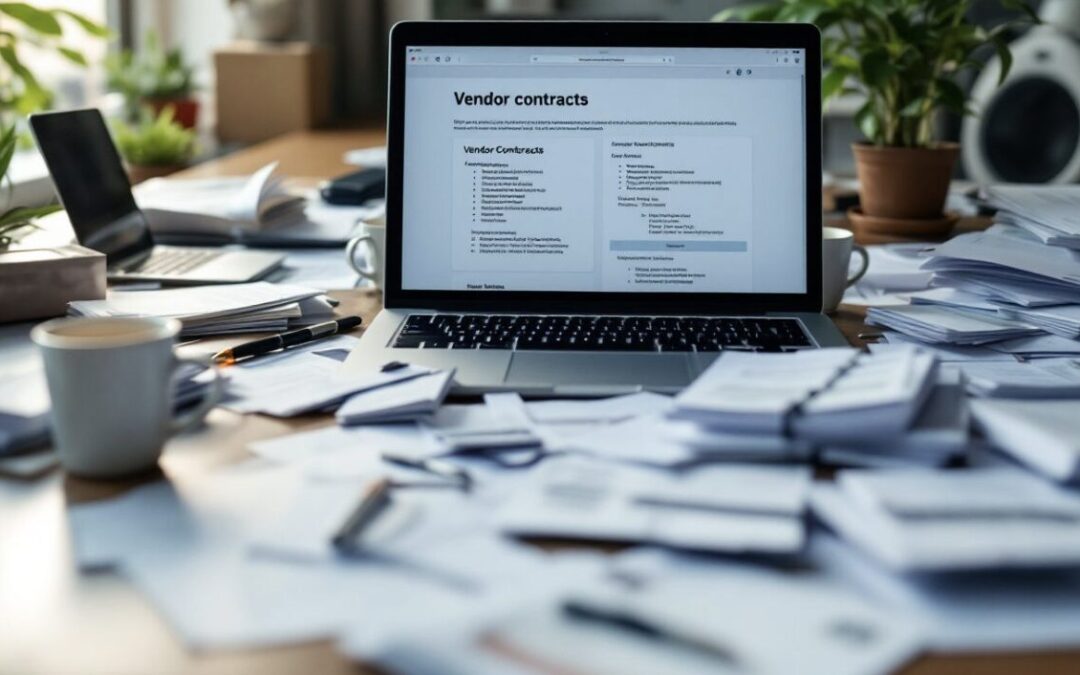Creating Accountability In Vendor Relationships
Having trouble with vendors not doing what they should? A key fact is that good vendor relationships make your business better. This article will show ways to make vendors more responsible, helping your projects succeed.
Importance of Accountability in Vendor Relationships
Accountability in vendor relationships is key for a business’s success. It makes sure that suppliers meet quality standards. This helps avoid risks and improves products and services.
Treating vendors as partners sets clear expectations. Open communication leads to mutual success.
Effective vendor management turns relationships into partnerships.
Next, let’s talk about defining roles and responsibilities.
Defining Roles and Responsibilities
Clear roles and jobs are key in vendor deals. This means stating who does what, when, and how. Including work scope, times, and results makes things clear. This stops mix-ups and sets clear hopes.
It also helps both sides know their duties well.
Having a solid policy on managing vendors cuts down on confusion. It helps everyone involved agree more easily. Next up, we’ll talk about setting goals and what we expect from each other.
Establishing Clear Goals and Expectations
Setting clear goals and expectations makes sure everyone knows what success looks like. To learn more, keep reading.
Setting measurable performance metrics
Clear performance metrics make sure vendor relationships work well. They help us know if vendors are doing what we expect.
- Decide what is important for your business. Pick things that show how well your vendor is doing.
- Align goals with the vendor. Make sure both of you want the same thing.
- Use KPIs to check progress. Key Performance Indicators (KPIs) are like a scorecard for your vendor’s work.
- Create specific objectives. Know exactly what success looks like.
- Set up performance benchmarks. These are targets the vendor should hit to be seen as doing a good job.
- Check on vendors often. Regularly look at how they are doing to make sure they meet benchmarks.
- Talk about results and ways to get better. Give feedback so vendors know how to improve.
- Adjust metrics if needed. Sometimes, goals change and metrics need to change too.
This approach makes sure both you and your vendors know what success looks like and how to get there together.
Creating detailed service level agreements (SLAs)
Service level agreements (SLAs) are key to a strong vendor relationship. They make sure vendors meet your needs and fix problems when they don’t.
- SLAs explain what services a vendor will give. This part tells you what help or product you will get.
- They include metrics for measuring success. These metrics show if the service is good or bad.
- The SLA lists what both sides must do. You know who does what.
- There are solutions if the vendor fails to deliver. This could mean money back or other help.
- Good SLAs push for the best work. They aim to get top results.
- Metrics should be easy to check. This makes it simple to see how things are going.
- The document changes as business needs do. It stays useful over time.
- Joint SLAs handle issues when many vendors work together. They help avoid problems between services.
- Avoid making these mistakes: not having an SLA, too many SLAs, and unclear rules.
This approach gives clear goals and fixes for problems, making working with vendors smoother and more predictable.
Leveraging Technology for Accountability
Using technology keeps everyone honest in vendor relationships—explore how it can change the game.
Using compliance tracking tools
Compliance tracking tools help keep an eye on vendors. They make sure vendors follow rules and meet standards. These tools use vendor risk monitoring checks. This helps catch any issues early.
For example, SafetyCulture offers a way to watch compliance easily.
Automation of compliance reduces paper work.
Companies can also score vendors with these tools. This scores how well a vendor does their job based on set rules and goals. Keeping track of this score helps companies decide which vendors are doing great and which need improvement.
Monitoring performance with real-time data
Real-time data helps keep an eye on vendor work as it happens. Tools like Open Kitchen and SiteSage send alerts right away if there’s a problem. This means building owners can fix things fast, before they get worse.
For example, getting alerted to a leak can cut down on water waste.
Using live data makes sure jobs are done right the first time. It also leads to spending less money on energy by fixing equipment quickly. Plus, these tools help track all actions taken for repairs.
This way, executives have clear records of what was fixed and when.
Communication and Transparency
Talking openly and sharing updates keeps everyone on the same page. Dive deeper to learn more!
Encouraging open and honest dialogue
Open dialogue means talking often. It’s important to have regular meetings or calls to go over how things are going with vendors. This helps keep everyone on the same page and builds trust.
Active listening to what vendors say is key. Give them a space for honest talks. This makes working together better. It also makes it easier to deal with problems fast, which keeps everyone accountable.
Regular performance reviews and feedback
Regular performance reviews and feedback boost continuous improvement. They ensure both sides agree on quality and expectations.
- Building owners should have meetings to talk about vendor work.
- Feedback must go two ways, from you and the vendor.
- It’s key to make a list of what good work looks like.
- Celebrate when vendors hit their goals.
- Use these talks for teaching moments too.
- Sharing insights helps everyone do better.
Moving forward, defining roles clearly is crucial.
Building Trust and Collaboration
Trust grows when both sides are fair and honest. This means keeping promises and being clear about what each side must do. For example, paying on time shows respect and earns trust.
Also, talking openly helps everyone understand each other better. Sharing goals and challenges makes the relationship stronger.
Working together also gets better when vendors help plan projects. This way, they can share in the success or learn from any failures together. Giving feedback kindly helps improve work over time.
These steps make the team more united and ready to tackle new challenges together.
Conclusion
Creating accountability in vendor relationships is key. AuditMate can help with this challenge. It offers tools for easy and effective management of vendors. With its data-driven approach, it makes sure vendors stick to their promises.
Need help managing vendor relationships? Contact AuditMate today.
FAQs
1. What does it mean to create accountability in vendor relationships?
Creating accountability in vendor relationships means ensuring both parties, the business and the vendor, are responsible for their actions and decisions.
2. Why is accountability important in vendor relationships?
Accountability is vital because it builds trust, ensures quality service, and fosters a strong working relationship between businesses and vendors.
3. How can I create more accountability with my vendors?
To foster more accountability with your vendors, establish clear expectations from the start, communicate regularly about performance metrics and goals, and always address any issues promptly.
4. Can creating better accountability improve my business operations?
Absolutely! Better accountability in your vendor relationships can lead to improved service delivery, increased efficiency in operations due to mutual understanding of roles and responsibilities.


